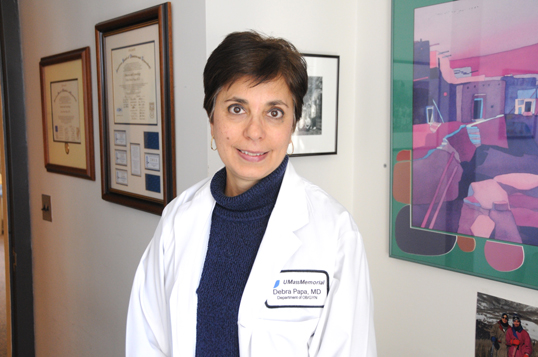
Debra Papa, MD
Should women be concerned about the FDA advisory committee’s approval of the Roche test for high risk human papilloma virus (HPV) for primary cervical cancer screening?
Debra Papa, MD, a gynecologist, says not to worry; patients won’t be seeing changes at their check-ups for a while, as guidelines on use have not yet been established.
“This is all very new, so we need to establish how it fits into actual clinical practice,” said Dr. Papa, assistant professor of obstetrics & gynecology. “The goal is more early detection, without increasing unnecessary procedures.”
The venerable Pap test is credited with dramatically reducing the incidence of cervical cancer in developed countries. But these reductions have leveled off in the United States. The FDA's Medical Devices Advisory Committee Microbiology Panel (Joanna Cain, MD, professor of obstetrics & bynecology at UMMS, is a member) notes in its recommendation that significant numbers of women in the United States continue to develop cervical cancer and die from it. This is due in part to the limitations of cytology as a screening test, which include subjectivity, and a relatively low sensitivity.
“We know that one HPV test is more sensitive in detecting high grade cervical dysplasia than one Pap, and that’s why it’s approved as the primary screen,” said Papa. “We’re already doing a good job in the United States with current screening, but with that first HPV test that’s positive, you may find that abnormality sooner. However, most women who develop cancer or pre-cancer of the cervix have not had any recent screening.”
The Roche HPV test specifically recommended by the FDA review committee individually identifies HPV 16 and 18, the two highest-risk HPV genotypes responsible for more than 70 percent of cervical cancer cases, while simultaneously detecting 12 other high-risk HPV genotypes.
Many women are already screened for HPV in combination with the Pap. The UMass Memorial Medical Center gynecology service that Papa belongs to currently screens women 30 and older with ThinPrep, which combines the traditional Pap test, in which scraped cervical cells are examined under a microscope by a cytologist, with an HPV test in which a machine detects high-risk HPV genotypes, including 16 and 18, in a liquid sample.
“What’s also nice about using HPV for primary screening is that it is reproducible, while Pap smears are not as reproducible,” said Papa. “But there is still validity of a Pap as it is more specific for high grade cervical dysplasia and certain types of cervical cancer. If you have a Pap showing a high grade abnormality, there is a good chance the woman has an abnormality. HPV testing is not as specific, which means that being high risk HPV positive does not mean a woman has an abnormality.
“So I don’t think cytology is going to be going away—I think it is going to be used as an adjunct to the HPV testing.”
Papa will not change her own practice until such clinical guidelines are established by additional expert bodies including the American Society for Colposcopy and Cervical Pathology and the American College of Obstetricians and Gynecologists, who will likely comment on the use of primary HPV screening in the near future.
“In the meantime I will tell patients that what may be coming soon is using the HPV test alone for first-line screening, but until then we are already testing for high risk HPV, including 16 and 18 in certain situations, along with their Pap,” she said.
Related links on UMassMedNow:
Study: Providers should keep talking about HPV vaccine to reluctant parents